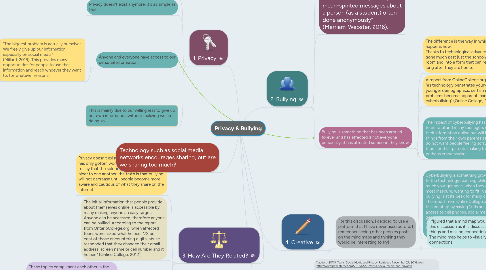
1. 1. Privacy
1.1. Privacy can be defined as "the quality or state of being apart from company or observation" (Merriam-Webster, 2016)
1.2. Privacy doesn't exist anymore, it's as simple as that.
1.3. Anyone and everyone have access to our personal information.
1.3.1. "The biggest problem is actually ourselves. We freely give up our information, especially on social media" (Millard, 2016). This provides many opportunities for people to use that information and reach whoever they want to, for whatever reasons.
1.3.1.1. According to Pew Research Center, "teen social media users do not express a high level of concern about third-parties accessing their data" (Madden, 2013). They still share their personal information willingly. The chart included above is from the same Pew Research Center report, and it states what personal information teenagers share online (Madden, 2013).
1.4. This is mainly due to our willingness to give up our own information without realizing we are doing so.
2. 3. How Are They Related?
2.1. Privacy doesn't exist, and ever since bullying has only gotten worse. As terrible as it sounds to say that the solution is not as easy as being nicer to one another, the truth is that bullying will not decrease until people become more aware and cautious of what they share on the internet.
2.2. The initial information that people provide about themselves online is accessible by many making anyone an easy target. Anyone can be accessed, therefore anyone can be bullied. According to the report from OntarioCollege.org, when affected teens were asked what helped, "72 per cent of those encountering digital abuse responded that they changed their email address, screen name or cell number and it helped" (Online College, 2012).
2.3. Compliment
2.3.1. These topics compliment each other in the sense that when privacy efforts are increased, there is less ammo for bullies to use. This would be stuff such as photos, location information, full names and contact information.
2.4. Oppose
2.4.1. Although efforts are being made to enhance privacy and hopefully lower the bullying, no one has a fully private life anymore and regardless of the efforts made, bullying is always going to be an issue; this makes the topics of privacy and bullying opposing.
3. Technology such as social media networks encourages sharing, but are we sharing too much?
4. References:
4.1. Madden. (2013). Teens, Social Media and Privacy. Retrieved November 27, 2016, from http://www.pewinternet.org/2013/05/21/teens-social-media-and-privacy/ Merriam-Webster. (2016). Definition of Privacy. Retrieved November 25, 2016, from http://www.merriam-webster.com/dictionary/privacy Merriam-Webster. (2016). Definition of Bullying. Retrieved November 25, 2016, from http://www.merriam-webster.com/dictionary/bullying Merriam-Webster. (2016). Definition of Cyberbullying. Retrieved November 25, 2016, from http://www.merriam-webster.com/dictionary/cyber%20bullying Online College. (2012). Cyberbullying: How Bullies Have Moved From the Playground to the Web. Retrieved November 27, 2016, from http://www.onlinecollege.org/cyberbullying/ The Associate Press. (2013). More Young People Reporting Cyberbullying to Parents. Retrieved November 27, 2016, from http://www.cbc.ca/news/more-young-people-reporting-cyberbullying-to-parents-1.2224076
5. 2. Bullying
5.1. According to Merriam-Webster, "today, a bully is usually one whose claims to strength and courage are based on the intimidation of those who are weaker" (Merriam-Webster, 2016).
5.2. Cyberbullying can be defined as "the electronic posting of mean-spirited messages about a person (as a student) often done anonymously" (Merriam-Webster, 2016).
5.3. Bullying is something that has been around forever and has affected if not everyone personally, it has affected someone they know.
5.3.1. The difference is the way in which bullying happens now. Thanks to technological advances, bullying has gone much past just the schoolyard and lunch room and into a form that can reach the victim long after they are home.
5.3.2. A report from OnlineCollege.org states that "as technology penetrates younger and younger demographics, certain social problems become apparent: namely, cyberbullying" (Online College, 2012).
5.3.3. The impact of cyberbullying has proven to be fatal and many teenagers share their information online but will hide things from their own parents as they do not want people feeling sorry for them, or their parents making things perhaps embarassing.
5.3.3.1. A poll by The Associated Press "found a growing awareness among teenagers and young adults about harm from online meanness and cyberbullying"
5.3.3.2. Although cyberbullying is prominent, “more young people are reaching out to family members after being harassed or taunted online, and it’s helping” (Associated Press, 2013)
5.3.4. Cyberbullying is something growing due to the technology reaching children at much younger ages, when they are the most insecure, wanting to fit in and when bullying is at its peak for many children. The report from OnlineCollege.org backs this point up by saying "kids are gaining access to cell phones, social media, and general communication platforms at ever earlier ages, and when this access is used to harm rather than help" (Online College, 2012)
6. 4. Creative
6.1. For this discussion, I decided to use a platform that I have never used before. I remember seeing other peoples posts on the mind maps and thinking they would be interesting to try!
6.1.1. I figured that a mind map would be good for this discussion as it is discussing 2 different things and making connections between them. The mind map helps to visually show these connections.

